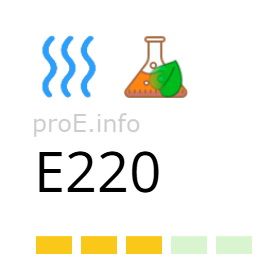
Other names for the additive (synonyms)
General Information
Sulfur dioxide (food additive E220) is a toxic gas used in the food industry as a preservative.
In the atmosphere, sulfur dioxide (SO₂) is present in very small amounts — usually less than 1 ppm, more often in the range of 0.1–1 ppb in clean areas. Its concentration increases significantly near volcanoes and in industrial regions where local emissions may occur.
Volcanoes and geothermal sources are the main natural sources of sulfur dioxide. During volcanic eruptions, large amounts of sulfur dioxide are released into the atmosphere. It can also form in swamps and seas during the decomposition of organic matter.
Additive E220 dissolves in water, forming unstable sulfurous acid. Sulfur dioxide is also soluble in sulfuric acid and ethanol. The chemical formula of sulfur dioxide is SO2.
There are several methods of producing sulfur dioxide. On an industrial scale, it is obtained by burning sulfur, roasting sulfides, or burning organic sulfur-containing compounds (such as hydrogen sulfide).
- S + O2 → SO2;
- 4FeS2 + 11O2 → 2Fe2O3 + 8SO2;
- 2H2S + 3O2 → 2H2O + 2SO2.
Main characteristics of food additive E220:
- Color – none.
- Odor – sharp, characteristic.
- Taste – none.
- Consistency – gas.
Effects on the Body
Risks of additive E220
Additive E220 is highly toxic. Inhalation of sulfurous gas causes coughing, runny nose, and suffocation. Prolonged exposure to sulfur dioxide can lead to vomiting, slurred speech, and acute pulmonary edema.
In allergic individuals, even small amounts of sulfur dioxide can cause hives, coughing, angioedema, and difficulty breathing.
The Center for Science in the Public Interest (CSPI), a non-profit consumer advocacy organization in the United States, recommends that certain individuals avoid the consumption of additive E220, as it destroys vitamin B1 and can trigger severe allergic reactions, especially in asthmatics (for whom sulfur dioxide is dangerous even at minimal concentrations of 0.1 mg per kg).
The same organization notes that sulfites, which form when sulfur dioxide dissolves in water, caused at least twelve deaths in the 1980s and likely many more in previous decades. Fatal cases were mostly linked to restaurant meals. Sulfite levels in salads and potatoes served in restaurants were often extremely high because workers allowed vegetables to sit in sulfite solution for too long.
As a result of pressure from the CSPI, Congressional hearings, and media attention, the FDA banned the most dangerous uses of sulfites and mandated labeling on wine bottles when sulfur dioxide is used. After these measures, no further fatalities were reported by CSPI.
It is also important to note that tolerance to sulfurous acid depends on the acidity of gastric juice. People with gastrointestinal diseases are more sensitive to sulfur dioxide in food. For non-sensitive individuals, sulfites are less dangerous.
Sulfur dioxide does not accumulate in the body. Food additive E220 is rapidly oxidized to sulfate and excreted in urine. In case of overdose symptoms, it is recommended to drink plenty of water to accelerate the elimination of the additive.
In 2024, EFSA withdrew the temporary acceptable daily intake (ADI) of 0.7 mg SO2 equivalents per kg body weight per day for additive E220 due to a lack of new toxicological data and recommended using a margin of exposure (MOE) approach. The European Commission also recommended lowering the maximum permitted levels of SO₂ in products.
Benefits of additive E220
The additive itself is not beneficial, but it is considered safe if its content in food products does not exceed the maximum permitted levels.
Uses
Food additive E220 is widely used to protect vegetables and fruits from premature browning and rotting. Sulfur dioxide is used to fumigate warehouses and storage facilities and is applied to almost all types of citrus fruits for further transportation.
Main purposes of food additive E220:
- preventing the growth of bacteria and fungi.
- slowing down enzymatic browning of vegetables and fruits.
- extending the shelf life of products.
Food additive E220 is used in the industrial production of dried fruits. It preserves the colorful appearance of fruits and prevents decay.
Additionally, sulfur dioxide is used:
- in the production of preserves: fruit and vegetable juices, purees, beverages – the additive helps extend their shelf life;
- in the manufacture of jams and marmalades;
- in meat processing – sulfur dioxide is applied to raw materials to protect them from spoilage bacteria and to enhance the product's color.
Sulfur dioxide is an important component in winemaking. Food additive E220 is used as an antibiotic and antioxidant, protecting wine from oxidation and bacterial spoilage. The antimicrobial action of additive E220 also helps minimize the formation of volatile acids in wine or juices.
Sulfur dioxide is present in all types of wine. The label “contains sulfites” indicates that sulfur dioxide has been used in wine processing. Additive E220 exists in wine in free and bound forms as well as their combinations. The maximum allowed amount of sulfur dioxide in wine should not exceed 350 parts per million, depending on the wine type and the country where the wine is sold. For example, in the EU, this limit is 160 ppm for red wines and 210 ppm for white and rosé wines.
Legal Status
As a result of pressure from the Center for Science in the Public Interest (CSPI), Congressional hearings, and media attention, the FDA banned the use of sulfites in many areas of the food industry in the United States.
Many countries require labeling on wine and other products indicating the use of sulfites.